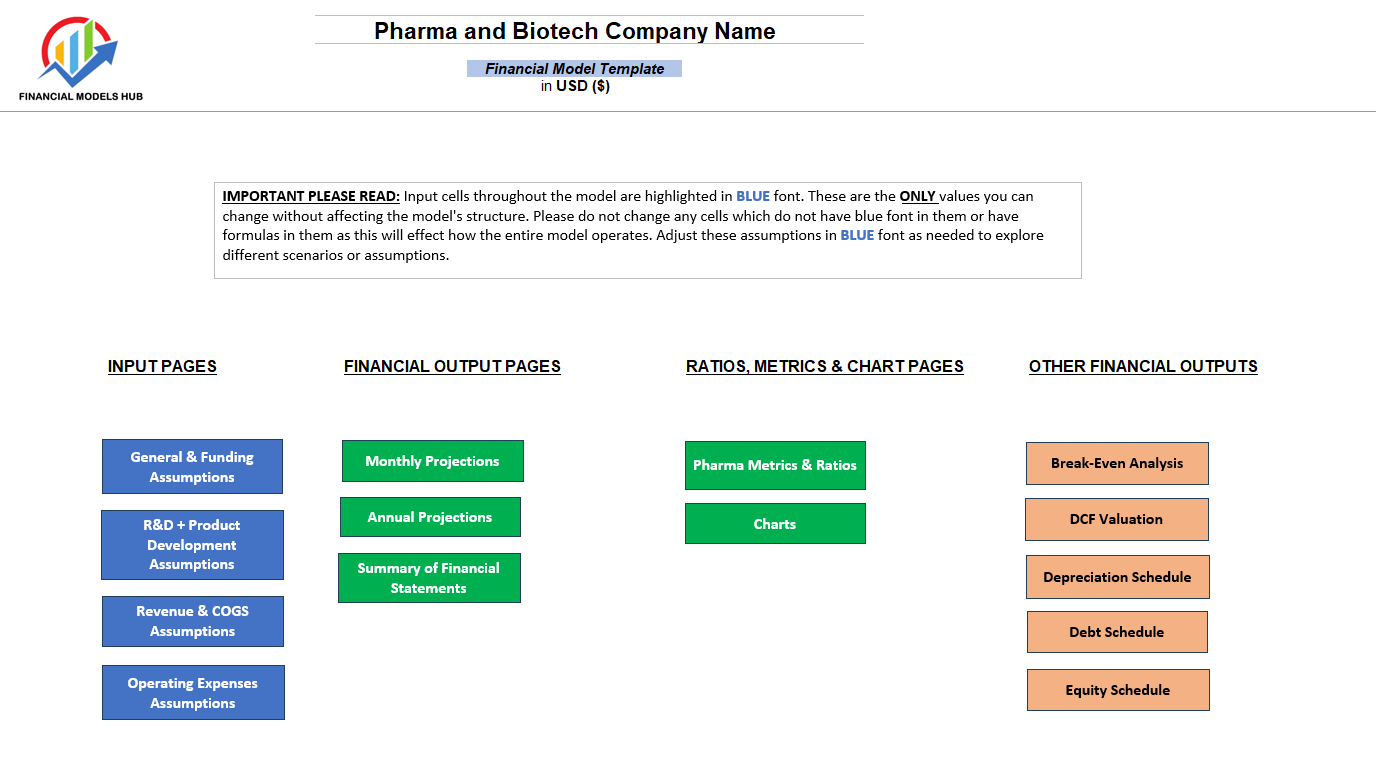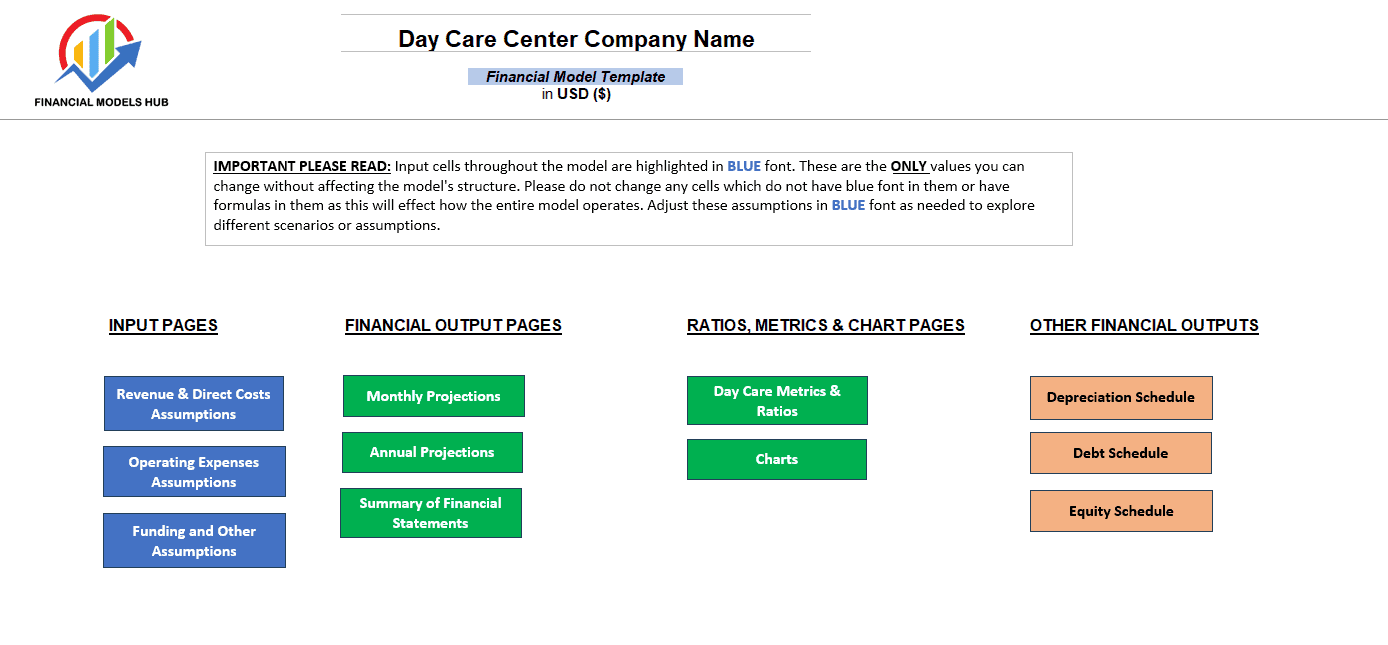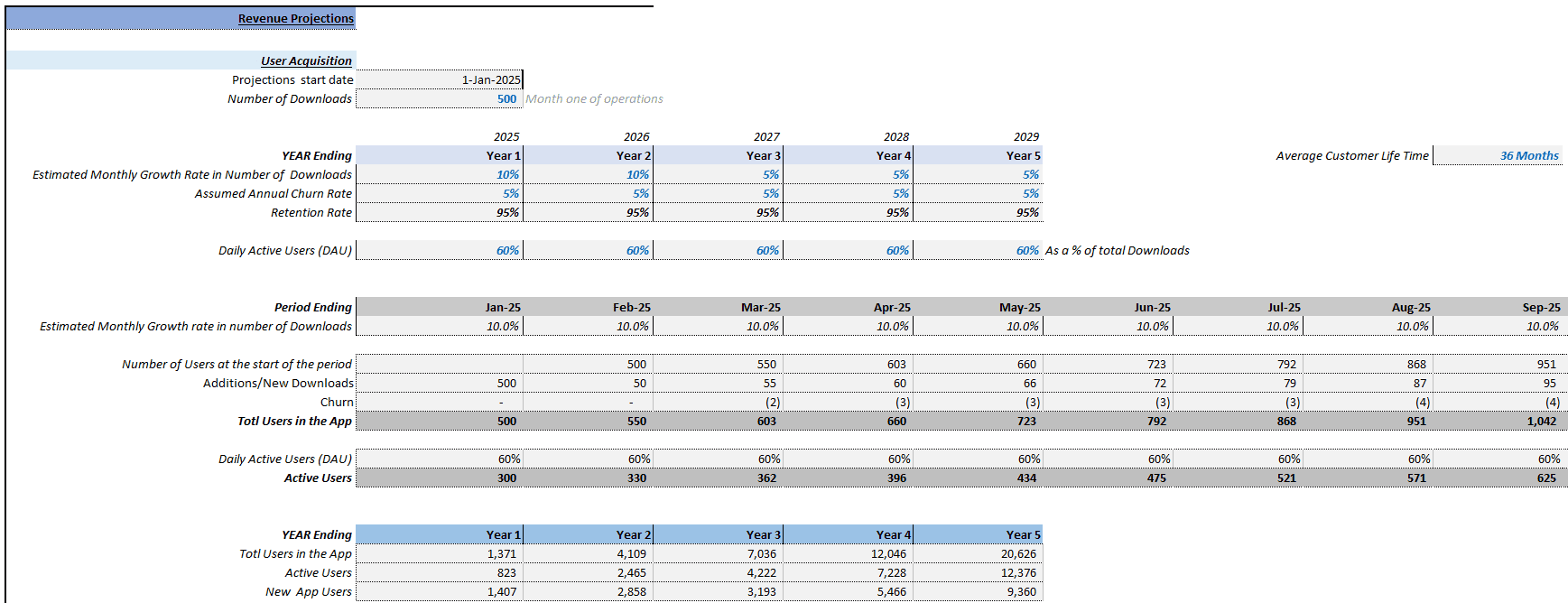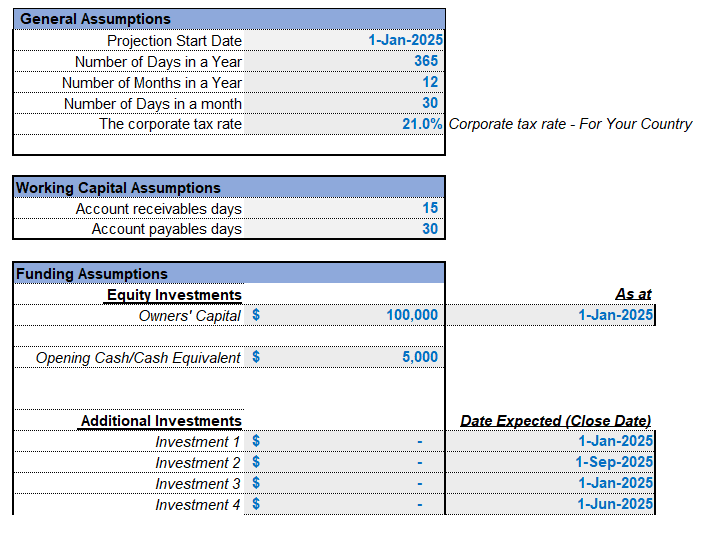This Pharma and Biotech Valuation and Financial Model Template has been built for use by any Pharma and Biotech entrepreneur looking for a simple to use 3 way financial model (Income Statement, Balance Sheet and Cash Flow). This model also incorporates a company valuation assessment to give the entrepreneur an idea of what their business is worth. The Model offers financial forecasts for 10 years and has been purposefully built to suit any Pharma and Biotech business with inputs for up to 10 individual Pharma and Biotech products with R&D and Product Development cost assumptions by product as well as Revenue and Operating Costs by product. Useful metrics, ratios, charts and summaries are also provided throughout the model and users will easily be able to navigate the model with all input fields highlighted in Blue font. These models are designed to be the perfect financial tool for business owners looking to make decisions for their company, forecast their company expectations and also look to see what their company is valued at based on future cash flow projections. This model can also be a perfect tool to give to external stakeholders or investors that want a snapshot of how a business is currently performing and what the forecasts look like.
General and Funding Assumptions
Starts with basic model questions on start date of the model, tax rate assumption, working capital assumptions and funding assumptions.
Research & Development (R&D) and Product Development Cost Assumptions
A Detailed Product by Product breakdown of R&D and Product Development Costs, with assumptions including Trial Start Date, Trial Period, Trial End Date and Success/Failure assessment.
Product Development and R&D Costs Assumptions have been segmented into:
- Research & Development (R&D) Costs: Pre-Clinical Costs, Phase I Trial Costs, Phase II Trial Costs, Phase III Trial Costs, Clinical Trial Management, Patient Recruitment, Laboratory Analysis and Testing, Regulatory Consulting and Quality Control & Assurance.
- Regulatory and Compliance Costs: Filing Fees for Regulatory Submissions, Safety Monitoring and Reporting, GMP Certification and Patent and Legal Fees.
- Manufacturing and Scale-up Costs: Pilot Manufacturing, Scale-up Production, Process Validation and Facility Costs.
- Marketing and Pre-Launch Costs: Market Research, Key Opinion Leader (KOL) Engagement, Brand Development, Medical Affairs and Education and Pricing Strategy Development.
- General & Administrative (G&A) Costs: Staffing and Labor Costs, Administrative Overheads, Insurance and Liability Coverage and Travel and Logistics.
Revenue and Direct Cost Assumptions
Revenue assumptions are the anticipated factors that drive a company’s income generation over a specific period. These assumptions form the basis for financial projections and are crucial for planning and decision-making. In our model we have included detailed inputs by Revenue category. We have included monthly input fields for 10 Pharma/Biotech products which includes the Average Selling Price Per Unit, Average Direct Costs Per Unit and Average Number of Units Sold Per Month.
Operating Expenses and Fixed Assets (Capex) Assumptions
Operating expense assumptions are typically based on historical data, industry benchmarks, market trends, and management’s judgment. They are crucial for estimating the total cost of running the business and for determining profitability. Like revenue assumptions, it’s important to regularly review and adjust operating expense assumptions to reflect changes in the business environment and ensure the accuracy of financial forecasts. In our model we have included detailed inputs on Staff costs (CEO, CFO, CSO, CMO, Head of R&D, Clinical Research Director, Regulatory Affairs Manager, Quality Assurance Manager, Quality Control Specialist, Clinical Data Manager, Biostatistician, Laboratory Technician, Manufacturing Supervisor, Process Development Scientist, Pharmacovigilance Specialist, Product Development Manager, Supply Chain Manager, Medical Science Liaison (MSL), Key Opinion Leader (KOL) Manager, Intellectual Property (IP) Manager and Other), and Typical Operational Expenditure items likely for a Pharma/Biotech business including Rent and Utilities, Office Supplies, Insurance, Marketing and Advertising, Travel and Meetings, Professional Services, IT, Training and Development, Legal Fees, Maintenance and Repairs, Research Materials and Supplies, however, you can add any other expenses you think may be relevant to your business in this sheet.
Capital expenditure (Capex) assumptions refer to the anticipated investments a company plans to make in long-term assets, such as property, plant, equipment, and technology, over a specific period. These assumptions are crucial for financial planning, budgeting, and forecasting, as they impact the company’s cash flow, profitability, and growth prospects. We have included Fixed Assets schedule which shows the main capex costs in a Pharma/Biotech business including Equipment and Machinery, Facility Construction/Leasehold Improvements, Laboratory Renovation, Technology and IT Infrastructure and Other Costs.
Monthly Projections (10 Year period)
We have broken down projections on a Month by Month basis when projecting Income Statement, Balance Sheet and Cash Flow Statement items. The monthly projections are provided over a 10 year time frame. This is particularly useful for businesses looking at month-on-month trends and insights in the business, which leads to better decision making and also better budgeting should there be a need to either raise more capital, pursue growth opportunities from excess capital or pay down interest bearing debt. Monthly projections also help a business ascertain what performance may be seasonal in nature when looking at growth projections on a month-over-previous-year’s-month basis.
Annual Projections (10 Year period)
The model has Annualized Financial Projections of Income Statement, Balance Sheet and Cash Flow Statement over a 10 year time frame. Annual projections provide an excellent overview of expected revenues, expenses, profits, cash flow, and other key financial metrics for the upcoming year. Annual projections are essential for strategic planning, budgeting, fundraising, and performance evaluation for any company at any stage of their business cycle.
Pharma and Biotech Financial Metrics & Other Metrics
Pharma and Biotech Financial metrics and Ratios have been included which highlights Revenue and Profitability metrics as well as R&D as a % of Sales, Average Time to Market, Clinical Trial Success Rate, Average Monthly Burn Rate.
Summary of Financial Statements
Summarized Financial Statements over a 10 year time frame helps for better snapshots of financial performance. Income Statement, Balance Sheet and Cash Flow Statement all provided.
Charts
Charts available including Profitability Margins (Gross Profit Margin, EBITDA Margin and Net Profit Margin), Revenue vs COGS Projections, Revenue vs Expenses, Trials (R&D and Initial Product Development Costs) and Cashflow Summary
Break Even Analysis
Shows Revenue and Costs to date including at what time it takes the Company to Break-Even.
DCF Valuation
We have included a Discounted Cash Flow (DCF) Valuation model showing the Net Present Value (NPV) of the Business based on a series of growth rates and assumptions. Weighted Average Cost of Capital Assumptions also provided including Risk Free rate, Beta, Risk Premium and Equity Risk Premium. A DCF valuation is a method used to estimate the value of an investment, business, or asset by discounting its expected future cash flows to present value. It is based on the principle that the value of an investment is determined by the present value of its future cash flows. The DCF valuation technique is widely used in finance, investment analysis, and corporate finance for making investment decisions, determining the fair value of securities, and evaluating the worth of businesses.
Depreciation Schedule
Detailed Depreciation Schedule shows additions / disposals to the Fixed Asset Register of the business. Sections included for Equipment and Machinery, Facility Construction/Leasehold Improvements, Laboratory Renovation, Technology and IT Infrastructure.
Debt Schedule
Debt schedule provided with interest rate assumptions and payback period assumptions included.
Equity Schedule
Equity schedule provided with assumptions on all investments into the business by investors or owners.















































Ying Z –
Comprehensive model! Just what I was looking for!
Frances L –
Perfect! I have used this model now to model out several pharma companies and works really well.
Michelle T –
As a CFO in early-stage biotech, this was a huge time-saver
Ravi S –
Really good model. Helped us visualize our funding needs through each clinical phase
Antony Cordan –
Best model i’ve seen on Pharma. Easy to follow too. Thank you again!
Nina V –
Clear, professional, and tailored for biotech—not just a generic startup model. Perfect for what we needed!
Carla –
Massive time and cost saving for us! We would have otherwise hired an expensive consultant to build this from scratch. This was just what we needed. Thank you again!!
Emily –
The built-in assumptions made it easy to model out different trial outcomes
Eva Gi –
Finally a model that works the way its supposed to! Also great price! i bought one that was for $200 and was not even as half as detailed as this. So easy to follow – this is excellent!
Laura M –
An excellent model that actually accounts for clinical phases and probability of success